Modeling Under PSD - PowerPoint PPT Presentation
Title:
Modeling Under PSD
Description:
Modeling Under PSD Air quality models (screening and refined) are used in various ways under the PSD program. Step 1: Significant Impact Analysis – PowerPoint PPT presentation
Number of Views:60
Avg rating:3.0/5.0
Title: Modeling Under PSD
1
Modeling Under PSD
- Air quality models (screening and refined) are
used in various ways under the PSD program. - Step 1 Significant Impact Analysis
- Use of either screening or refined model to
determine if emissions from PSD project alone are
significant through use of Significant Impact
Levels (SILs) - Step 2 Cumulative Impact Analysis
- Use of refined models to determine cumulative
impacts from PSD project in conjunction with
nearby sources does not cause or contribute to
violations of applicable NAAQS and increments.
2
Modeling Guidance for 1-Hour NO2 NAAQS Under PSD
- PSD regulations require that modeling be
conducted in accordance the Guideline on Air
Quality Models - AERMOD is the EPA Preferred Model for PSD
modeling for all criteria pollutants (except O3).
- Appendix W outlines 3-tiered screening level
procedures to address conversion of NO2 from NOx
emissions. - We believe that sources will benefit
significantly from use of the conversion guidance
(Tier 3 options) rather than conservative
assumptions that all or most NOx is NO2 (Tier 1
2 options) - Fully expect more Tier 3 uses of AERMOD with
detailed screening methods (Ozone Limiting Method
and Plume Volume Molar Ratio Method) that will
need to be approved by Regional Offices and may
need to be vetted through Model Clearinghouse
3
Preliminary Assessment Source Impacts for the
1-Hour NO2 NAAQS
- New major sources with lower level releases
(short stacks) may show modeled violations of the
NAAQS - Some states (e.g., in Regions 4, 6,and 7) are
reporting preliminary permitting challenges
with respect to new 1-hour NO2 NAAQS. - Minor sources that have not historically been
required to model may have trouble meeting the
new NAAQS - In order to better understand the extent of the
problem, OAQPS is compiling details of the
preliminary data being reported to identify
emissions input assumptions, form of hourly
impacts relative to standard, NOX chemistry
options
4
Upcoming Modeling Guidance for NO2 NAAQS
- EPAs current regulatory permit model, AERMOD
will be used for modeling compliance with the NO2
1-hr NAAQS, with additional guidance and tools to
be provided to facilitate its use - Provide clarification memo on how Appendix Ws
3-tiered screening level procedures, involving
the conversion of NOx to NO2, apply to new hourly
standard - Tier 1 100 conversion
- Tier 2 75 conversion based on ambient ratio
method - Tier 3 Case-by-case methods requiring more
detailed inputs (stack ratios, background O3,
etc). - Also will provide background on inventory
development methods to generate hourly emissions
for purposes of modeling NO2 - Provide post-processing capability within AERMOD
to generate appropriate modeling results for
comparison to new hourly standard - Date for issuing guidance and providing
processing tool May 28, 2010 - Once nonattainment designations are completed for
NO2, modeling and technical guidance needed to
S/L/T to support nonattainment SIP demonstrations
5
PM2.5 Permit Modeling Guidance Background
- August 2009 Administrative Order on LGE
essentially established two paths forward in
addressing PM2.5 for permits - Demonstrate adequacy of PM10 surrogacy policy for
PM2.5 - Conduct PM2.5 permit modeling
- March 23, 2010 Page Memorandum provides
- Clarifications on demonstrating the
appropriateness of PM10 surrogacy policy to
comply with PM2.5 NAAQS - Provides recommended modeling procedures for two
main stages in PSD ambient impact analysis, i.e.,
Significant Impact Analysis and Cumulative Impact
Analysis - Differences in nature of PM2.5 from other
criteria pollutants and the form of the daily
NAAQS standard means that standard modeling
practices may not be appropriate - Recognizing this and associated technical
difficulties, PSD modeling for PM2.5 should be
viewed as screening-level analysis similar to
Appendix W approach for NO2 (Section 5.2.4)
6
Technical Elements of PM2.5 Permit Modeling
- Modeling Inventory
- Develop an emissions inventory of background
sources to be included in modeling analysis using
traditional guidance - Dispersion Modeling
- Use AERMOD as the EPA Preferred Model for
permit modeling to account for primary emissions
from project sources nearby sources, as
appropriate - Background Concentrations
- Determine representative background
concentration and use DV metrics for annual and
daily PM2.5 stds - Accounts for majority of secondarily formed PM2.5
(to be determined extent to which account for
projects contribution by its precursor emissions)
7
Comparison to PM2.5 SIL and NAAQS
- Significant Impact Analysis
- For 5 years of NWS met data, use highest average
of modeled annual averages and average of first
highest 24-hr average - Cumulative Impact Analysis
- NAAQS 1st Tier Combine background as DV metric
with modeled result (based on same modeling
metric for SIL comparison) - NAAQS 2nd Tier (for daily) where modeled PM2.5
emissions are not temporally correlated with
background PM2.5 levels then combine on a
seasonal or quarterly basis - NAAQS 3rd Tier (for daily) consider more
temporal and spatial pairing to determine better
basis
8
PM2.5 Permit Modeling Activities and Plans
- EPA-NACAA PM2.5 Modeling Workgroup to gain
State/local agency input by October 2010 on - Development of emissions inventories
- Determination of Representative background
- Accounting for secondary formation from project
source - Issue PM2.5 permit modeling guidance
- Compile experiences and recommendations into
draft guidance by Fall 2010 - Host workshop to discuss and gain public input on
draft guidance - Issue final PM2.5 permit modeling guidance by
end of year or early 2011 - PLEASE NOTE PM2.5 modeling for permits will
continue in interim so seek technical input from
Regional Offices and vet technical issues with
OAQPS through the Model Clearinghouse































